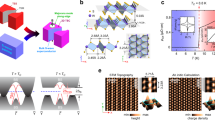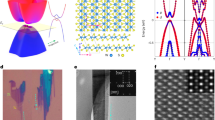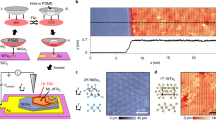Abstract
Searching for Majorana bound states has become an important topic because of its potential applications in topological quantum computing. 2M-phase WS2, a newly synthesized superconductor, not only presents the highest superconducting transition temperature (Tc = 8.8 K) among the intrinsic transition metal dichalcogenides but also is predicted to be a promising candidate as a topological superconductor. Using scanning tunnelling microscopy, we observe a U-shaped superconducting gap in 2M-WS2. Probable Majorana bound states are observed in magnetic vortices, which manifest as a non-split zero-energy state coexisting with the ordinary Caroli–de Gennes–Matricon bound states. Such non-split bound states in 2M-WS2 show highly spatial anisotropy, originating from the anisotropy of the superconducting order parameter and Fermi velocity. Due to its simple layered structure and substitution-free lattice, 2M-WS2 can be a building block to construct novel heterostructures and provides an ideal platform for the study of Majorana bound states.
This is a preview of subscription content, access via your institution
Access options
Access Nature and 54 other Nature Portfolio journals
Get Nature+, our best-value online-access subscription
$29.99 / 30 days
cancel any time
Subscribe to this journal
Receive 12 print issues and online access
$209.00 per year
only $17.42 per issue
Buy this article
- Purchase on Springer Link
- Instant access to full article PDF
Prices may be subject to local taxes which are calculated during checkout






Similar content being viewed by others
Data availability
The data that support the plots within this paper and other findings of this study are available from the corresponding author upon reasonable request.
References
Kopnin, N. B. & Salomaa, M. M. Mutual friction in superfluid 3He: effects of bound states in the vortex core. Phys. Rev. B 44, 9667–9677 (1991).
Read, N. & Green, D. Paired states of fermions in two dimensions with breaking of parity and time-reversal symmetries and the fractional quantum Hall effect. Phys. Rev. B 61, 10267 (2000).
Das Sarma, S., Nayak, C. & Tewari, S. Proposal to stabilize and detect half-quantum vortices in strontium ruthenate thin films: non-Abelian braiding statistics of vortices in a p x + ip y superconductor. Phys. Rev. B 73, 220502 (2006).
Fu, L. & Berg, E. Odd-parity topological superconductors: theory and application to CuxBi2Se3. Phys. Rev. Lett. 105, 097001 (2010).
Nadj-Perge, S. et al. Observation of Majorana fermions in ferromagnetic atomic chains on a superconductor. Science 346, 602–607 (2014).
Mourik, V. et al. Signatures of Majorana fermions in hybrid superconductor–semiconductor nanowire devices. Science 336, 1003–1007 (2012).
Rokhinson, L. P., Liu, X. & Furdyna, J. K. The fractional a.c. Josephson effect in a semiconductor–superconductor nanowire as a signature of Majorana particles. Nat. Phys. 8, 795–799 (2012).
Xu, J. P. et al. Experimental detection of a Majorana mode in the core of a magnetic vortex inside a topological insulator–superconductor Bi2Te3/NbSe2 heterostructure. Phys. Rev. Lett. 114, 017001 (2015).
Sun, H.-H. et al. Majorana zero mode detected with spin selective Andreev reflection in the vortex of a topological superconductor. Phys. Rev. Lett. 116, 257003 (2016).
He, Q. L. et al. Chiral Majorana fermion modes in a quantum anomalous Hall insulator–superconductor structure. Science 357, 294–299 (2017).
Wang, Z. et al. Topological nature of the FeSe0.5Te0.5 superconductor. Phys. Rev. B 92, 115119 (2015).
Zhang, P. et al. Observation of topological superconductivity on the surface of an iron-based superconductor. Science 360, 182–186 (2018).
Wang, D. et al. Evidence for Majorana bound states in an iron-based superconductor. Science 362, 333–335 (2018).
Liu, Q. et al. Robust and clean Majorana zero mode in the vortex core of high-temperature superconductor (Li0.84Fe0.16)OHFeSe. Phys. Rev. X 8, 041056 (2018).
Qian, X., Liu, J., Fu, L. & Li, J. Quantum spin Hall effect in two-dimensional transition metal dichalcogenides. Science 346, 1344–1347 (2014).
Fei, Z. et al. Edge conduction in monolayer WTe2. Nat. Phys. 13, 677–682 (2017).
Tang, S. et al. Quantum spin Hall state in monolayer 1T′-WTe2. Nat. Phys. 13, 683–687 (2017).
Wu, S. et al. Observation of the quantum spin Hall effect up to 100 kelvin in a monolayer crystal. Science 359, 76–79 (2018).
Soluyanov, A. A. et al. Type-II Weyl semimetals. Nature 527, 495–498 (2015).
Deng, K. et al. Experimental observation of topological Fermi arcs in type-II Weyl semimetal MoTe2. Nat. Phys. 12, 1105–1110 (2016).
Jiang, J. et al. Signature of type-II Weyl semimetal phase in MoTe2. Nat. Commun. 8, 13973 (2017).
Fu, L. & Kane, C. L. Superconducting proximity effect and Majorana fermions at the surface of a topological insulator. Phys. Rev. Lett. 100, 096407 (2008).
Qi, Y. et al. Superconductivity in Weyl semimetal candidate MoTe2. Nat. Commun. 7, 11038 (2016).
Yang, H., Kim, S. W., Chhowalla, M. & Lee, Y. H. Structural and quantum-state phase transitions in van der Waals layered materials. Nat. Phys. 13, 931–937 (2017).
Fang, Y. et al. Coexistence of intrinsic superconductivity and topological insulator state in monoclinic phase WS2. Preprint at https://arxiv.org/abs/1808.05324 (2018).
Hoffman, J. E. et al. Imaging quasiparticle interference in Bi2Sr2CaCu2O8 + δ. Science 297, 1148–1151 (2002).
Crommie, M. F., Lutz, C. P. & Eigler, D. M. Imaging standing waves in a two-dimensional electron gas. Nature 363, 524–527 (1993).
Jiang, Y. et al. Landau quantization and the thickness limit of topological insulator thin films of Sb2Te3. Phys. Rev. Lett. 108, 016401 (2012).
Zhang, T. et al. Experimental demonstration of topological surface states protected by time-reversal symmetry. Phys. Rev. Lett. 103, 266803 (2009).
Fu, L. Odd-parity topological superconductor with nematic order: application to CuxBi2Se3. Phys. Rev. B 90, 100509 (2014).
Matano, K., Kriener, M., Segawa, K., Ando, Y. & Zheng, G.-q. Spin-rotation symmetry breaking in the superconducting state of CuxBi2Se3. Nat. Phys. 12, 852–854 (2016).
Yonezawa, S. et al. Thermodynamic evidence for nematic superconductivity in CuxBi2Se3. Nat. Phys. 13, 123–126 (2017).
Chen, M., Chen, X., Yang, H., Du, Z. & Wen, H.-H. Superconductivity with twofold symmetry in Bi2Te3/FeTe0.55Se0.45 heterostructures. Sci. Adv. 4, eaat1084 (2018).
Liu, D. et al. Orbital origin of extremely anisotropic superconducting gap in nematic phase of FeSe superconductor. Phys. Rev. X 8, 031033 (2018).
Caroli, C., De Gennes, P. G. & Matricon, J. Bound fermion states on a vortex line in a type II superconductor. Phys. Lett. 9, 307–309 (1964).
Hess, H. F., Robinson, R. B., Dynes, R. C., Valles, J. M.Jr. & Waszczak, J. V. Scanning-tunneling-microscope observation of the Abrikosov flux lattice and the density of states near and inside a fluxoid. Phys. Rev. Lett. 62, 214–216 (1989).
Shore, J. D., Huang, M., Dorsey, A. T. & Sethna, J. P. Density of states in a vortex core and the zero-bias tunneling peak. Phys. Rev. Lett. 62, 3089–3092 (1989).
Hess, H. F., Robinson, R. B. & Waszczak, J. V. Vortex-core structure observed with a scanning tunneling microscope. Phys. Rev. Lett. 64, 2711–2714 (1990).
Fischer, Ø., Kugler, M., Maggio-Aprile, I., Berthod, C. & Renner, C. Scanning tunneling spectroscopy of high-temperature superconductors. Rev. Mod. Phys. 79, 353–419 (2007).
Stone, M. & Chung, S.-B. Fusion rules and vortices in p x + ip y superconductors. Phys. Rev. B 73, 014505 (2006).
Chiu, C.-K., Gilbert, M. J. & Hughes, T. L. Vortex lines in topological insulator–superconductor heterostructures. Phys. Rev. B 84, 144507 (2011).
Hayashi, N., Ichioka, M. & Machida, K. Effects of gap anisotropy upon the electronic structure around a superconducting vortex. Phys. Rev. B 56, 9052–9063 (1997).
Yazdani, A., Jones, B. A., Lutz, C. P., Crommie, M. F. & Eigler, D. M. Probing the local effects of magnetic impurities on superconductivity. Science 275, 1767–1770 (1997).
Pan, S. H. et al. Imaging the effects of individual zinc impurity atoms on superconductivity in Bi2Sr2CaCu2O8 + δ. Nature 403, 746–750 (2000).
Hudson, E. W. et al. Interplay of magnetism and high-T c superconductivity at individual Ni impurity atoms in Bi2Sr2CaCu2O8 + δ. Nature 411, 920–924 (2001).
Balatsky, A. V., Vekhter, I. & Zhu, J.-X. Impurity-induced states in conventional and unconventional superconductors. Rev. Mod. Phys. 78, 373–433 (2006).
Roushan, P. et al. Topological surface states protected from backscattering by chiral spin texture. Nature 460, 1106–1109 (2009).
Qi, X.-L. & Zhang, S.-C. Topological insulators and superconductors. Rev. Mod. Phys. 83, 1057–1110 (2011).
Potter, A. C. & Lee, P. A. Engineering a p + ip superconductor: comparison of topological insulator and Rashba spin–orbit-coupled materials. Phys. Rev. B 83, 184520 (2011).
Acknowledgements
We thank Y. Zhang and Z. Wang for helpful discussions. The experimental work was supported by the National Science Foundation (nos. 11674191 and 11674165), the Ministry of Science and Technology of China (no. 2016YFA0301002) and the Beijing Advanced Innovation Center for Future Chip (ICFC), the National Key R&D Program of China (grant no. 2016YFB0901600), the Science and Technology Commission of Shanghai (grant no. 16JC1401700) and the CAS Center for Excellence in Superconducting Electronics. W.L. was also supported by the Tsinghua University Initiative Scientific Research Program, Beijing Young Talents Plan and the National Thousand-Young-Talents Program.
Author information
Authors and Affiliations
Contributions
W.L., F.H. and Q.-K.X. designed and coordinated the experiments. Y.Y. and X.W. carried out the STM experiments, and J.P. and Y.F. grew the samples. H.Z., X.M., K.H., L.W. and C.S. contributed to discussions about the data. W.L. and Y.Y. wrote the manuscript with comments from all authors.
Corresponding authors
Ethics declarations
Competing interests
The authors declare no competing interests.
Additional information
Publisher’s note: Springer Nature remains neutral with regard to jurisdictional claims in published maps and institutional affiliations.
Supplementary information
Supplementary information
Additional theoretical and experimental details, Supplementary Figs. 1–10 and Supplementary references 1–3.
Rights and permissions
About this article
Cite this article
Yuan, Y., Pan, J., Wang, X. et al. Evidence of anisotropic Majorana bound states in 2M-WS2. Nat. Phys. 15, 1046–1051 (2019). https://doi.org/10.1038/s41567-019-0576-7
Received:
Accepted:
Published:
Issue Date:
DOI: https://doi.org/10.1038/s41567-019-0576-7
This article is cited by
-
High intrinsic phase stability of ultrathin 2M WS2
Nature Communications (2024)
-
Topological superconductor candidates PdBi2Te4 and PdBi2Te5 from a generic ab initio strategy
npj Computational Materials (2023)
-
Anomalous enhancement of the Nernst effect at the crossover between a Fermi liquid and a strange metal
Nature Physics (2023)
-
A highly anisotropic polymorph
Nature Physics (2023)
-
Spin–orbit–parity coupled superconductivity in atomically thin 2M-WS2
Nature Physics (2023)



